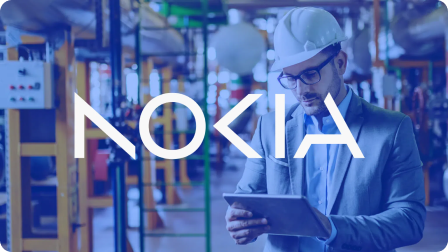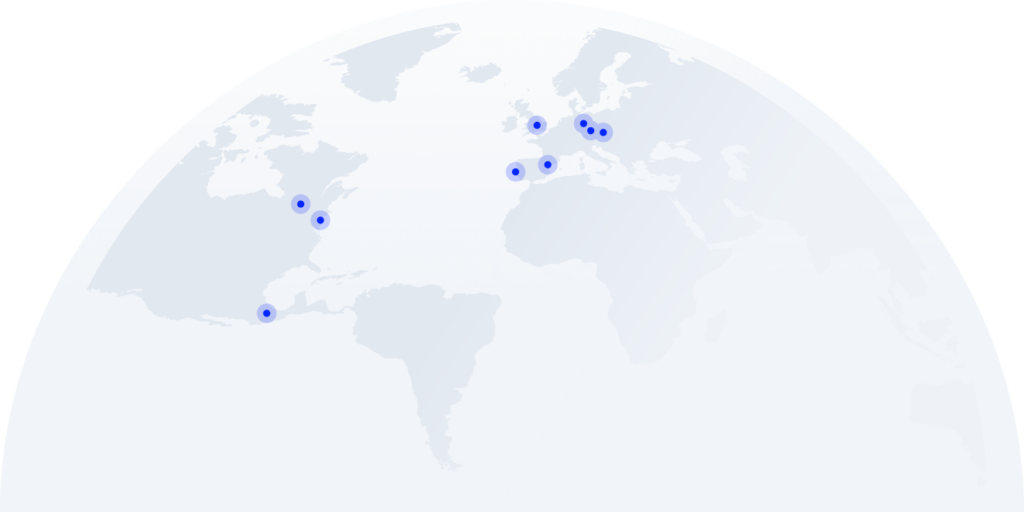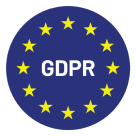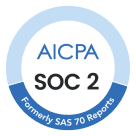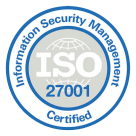7 Top Metrics for Measuring Customer Service Efficiency

Customer service directly impacts your bottom line, influencing everything from customer retention to acquisition costs. In fact, 73% of consumers will switch to a competitor after multiple bad experiences.
Are you truly maximizing your resources or leaking revenue through slow response times and unresolved issues? The truth lies in the data.
And that data is your customer service metrics that reveal the actual efficiency of your operations.
In this article, we’re going beyond surface-level observations to explore the top metrics that will give you a clear, actionable understanding of your performance. Then, we’ll share some actionable insights into how to interpret these metrics and use them to identify areas for improvement.
Key Takeaways:
- Efficient customer service drives customer loyalty, enhances satisfaction, and supports revenue growth by turning first-time buyers into repeat customers.
- Tracking key performance indicators provides a clear picture of performance, helping identify operational gaps and inform improvements.
- Implementing AI-powered tools and real-time analytics, such as those offered by CloudTalk, can help streamline processes, reduce resolution times, and improve the overall customer experience.
- Implementing practical tips such as smarter call routing, automating repetitive tasks, and using targeted training based on metric insights ensures continuous service improvement.
Transform your strategy now. Optimize your customer service KPIs.
Why It Is Important to Measure Customer Service Efficiency
Measuring customer service efficiency pinpoints performance gaps that directly impact revenue, customer retention, and operational costs.
If customers are the heart of your business, customer service is the pulse.
Let’s look at some of the vital signs that show a healthy, successful business:
- Increased customer satisfaction and loyalty: When customers experience positive and empathetic support, they’re more likely to feel valued and appreciated. This breeds loyalty and turns one-time buyers into repeat customers. Loyal customers become the bedrock of sustainable growth, helping your business see consistent revenue and positive word-of-mouth referrals.
- Strong revenue growth: Customer service is a key driver of revenue growth. When loyal customers use your services (and spend more over time), your customer lifetime value (CLV) increases. According to Yotpo, 82.5% of consumers tend to buy from the same company if they feel that it resonates with them.
The Impact of Data-Driven Decision-Making
Data-driven decision-making allows you to use concrete data and analysis to understand performance and drive improvements.

So, instead of saying your customer service is “good” or “bad,” you can track KPIs. That way, you get a clear and accurate picture of customer service performance.
CloudTalk’s AI-powered analytics is your solution for unlocking 100% call insights, automatically delivered. You can effortlessly monitor key metrics, identify trends, and get a better understanding of your customers.
Identify customers’ concerns to make better decisions with CloudTalk’s real-time insights.
When it comes to improving customer service, we can’t just rely on data analytics. You have to identify key metrics, analyze trends, and take specific actions—like reducing response times or improving first-call resolution—to drive measurable efficiency.
That’s where AI decision-making steps in. Rather than relying on outdated workflows or gut feelings, AI will analyze patterns in real time and suggest the best next move.
Say a customer has reached out multiple times about the same issue. AI can flag that and route them to a specialist instead of making them start over with a new customer service agent.
It can also spot trends, like a spike in complaints about a certain product so that you can act before a flood of tickets rolls in. This helps make every interaction smoother, faster, and more effective.
7 Metrics for Measuring Customer Service Efficiency
In your journey to providing exceptional customer service, you need concrete data to understand where your team excels, where your processes break down, and, ultimately, how your customers truly feel.
These seven key metrics provide a powerful lens to measure your customer service efficiency.
#1 Average Handling Time (AHT)
AHT refers to the average time a customer service representative takes to resolve an issue. The clock runs from the moment a customer initiates contact to the final resolution. This includes talk time, hold time, and any follow-up tasks to complete.
If you have a lower AHT, that’s a good sign that your customer service process is efficient. But make sure it’s not coming at the expense of quality service. You want to strike the right balance between being fast and thorough. This will ensure your customers are getting quick resolutions without feeling like you’re rushing or undervaluing them.
Tips for reducing AHT:
- Use AI-powered tools to route calls to the right agent the first time.
- Automate repetitive tasks like data entry, updating customer records, or sending follow-up emails.
- Set up self-service tools, like FAQs, chatbots, or automated help centers.
- Equip agents with easy-to-access knowledge bases and call scripts that solve common issues.
CloudTalk can help support your efforts to improve AHT without sacrificing quality customer service. We offer a variety of integrated call center tools so your agents can streamline their work processes. This reduces the time they spend on administrative tasks and lets them focus more on the customer.
Our automation features take care of repetitive tasks like logging information or sending follow-up emails. This helps agents speed up after-call work (ACW), which means they can get through their post-call tasks faster, without cutting corners.call.
See the difference now.
Ready to boost your customer service team’s efficiency?
#2 First Call Resolution (FCR) Rate
FCR refers to the percentage of client issues that reps resolve during the first interaction. These calls don’t require follow-up calls or escalations.
When customers don’t have to follow up or repeat their issues, they feel valued and heard. This immediate resolution also eliminates frustration, improves the customer’s experience, and reduces the time they spend on back-and-forth interactions with the customer care team.
CloudTalk allows you to improve FCR by offering skill-based routing and advanced analytics.
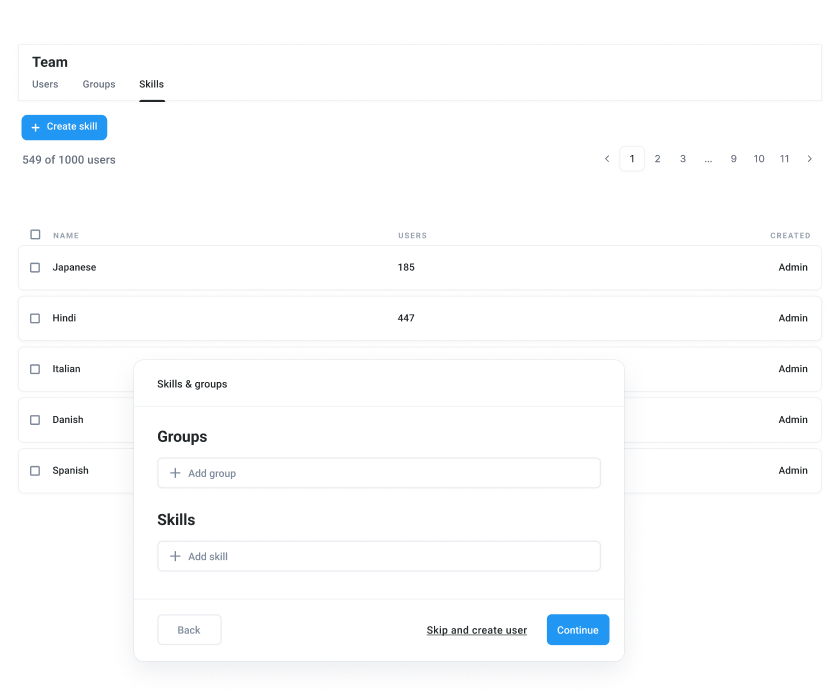
This means that when a customer calls, the call directs them to the agent with the right expertise to address their specific needs. Powerful analytics tools help you to continuously track and improve FCR rates.
#3 Customer Satisfaction Score (CSAT)
CSAT measures your customers’ satisfaction with a specific interaction, product, or service. You can typically gather this information from post-interaction surveys, where customers use a scale of 1-5 or 1-10 to rate their experience (e.g., 1-5 or 1-10).
Have a high CSAT score? Your customers feel like you’re meeting their needs. Low score? There’s room for improvement.
Since CSAT is directly tied to how customers feel about your service, make sure you’re regularly monitoring this metric. That way, you’ll be able to identify patterns and adjust strategies to enhance overall service quality.
Tips for improving CSAT:
- Use customer data to understand previous interactions and preferences.
- Offer agents detailed customer profiles to provide more relevant and personalized solutions.
- Reach out to customers with updates before they ask. (Ex: Notifying customers about the status of an ongoing issue or when a product is back in stock).
CloudTalk offers several tools to help you achieve a higher CSAT by improving how agents interact with customers.
- Cut handling time by 40% with analytics: CloudTalk’s dashboard offers real-time insights into key support metrics like average handling time, call resolution, and agent performance.
- Win with data that drives decisions: Get a clear view of call outcomes, resolution trends, and agent efficiency with CloudTalk’s real-time reports and performance tracking.
- Deliver standout customer experiences: Use CloudTalk’s call tagging and CRM tools to uncover patterns, understand customer needs, and improve interactions.
- Boost team performance with live tracking: CloudTalk’s real-time agent monitoring helps you optimize support by viewing performance metrics during each call.
Want to see CloudTalk in action to increase your CSAT response rate? Subscribe now!
#4 Net Promoter Score (NPS)
NPS shows how loyal customers are to your brand and how likely they are to recommend your company to others.
You get this from the answers your customers provide in survey questions like “On a scale of 0-10, how likely are you to recommend our company to a friend or colleague?”

When measuring NPS, you categorize customers into three groups:
- Promoters (9-10): Loyal customers who actively recommend your business.
- Passives (7-8): Satisfied but not enthusiastic customers who may switch to competitors.
- Detractors (0-6): Unhappy customers who would damage your reputation through negative word-of-mouth.
To improve NPS:
- Ensure that your customer support agents engage with customers in a more personalized way.
- Reach out to customers regularly with updates, reminders, and helpful information.
- Improve response times.
- Use multiple contact channels where you can receive customer issue requests (make sure to provide a fast response on all of them).
- After interacting with detractors, ask for specific feedback about what went wrong and how you can improve.
- In cases where a detractor has had a negative experience, offer a refund, discount, or free service to win back their trust and show that you value their business.
- Once you resolve an issue, follow up with customers to make sure they’re satisfied with the outcome.
#5 Average Speed of Answer (ASA)
ASA is the average time it takes for a customer service rep to answer a customer’s call or message.
This helps gauge how quickly your team responds to customer queries, which can significantly impact the overall customer experience.
You might notice that ASA is very similar to AHT. The key difference is ASA is about speed to answer, while AHT is about speed to resolve.
Ideally, you want both to be balanced. Fast responses (low ASA) should lead to efficient resolutions (low AHT). But make sure you’re not sacrificing quality in the process.
Tips for reducing ASA:
- Implement intelligent call routing systems that immediately direct customers to the right department or agent.
- Use CloudTalk’s smart call queuing to route customers to the appropriate agents based on availability and skill set.
- Prioritize calls based on urgency. CloudTalk allows you to prioritize calls based on their importance. For example, you can give urgent customer issues priority in the queue.
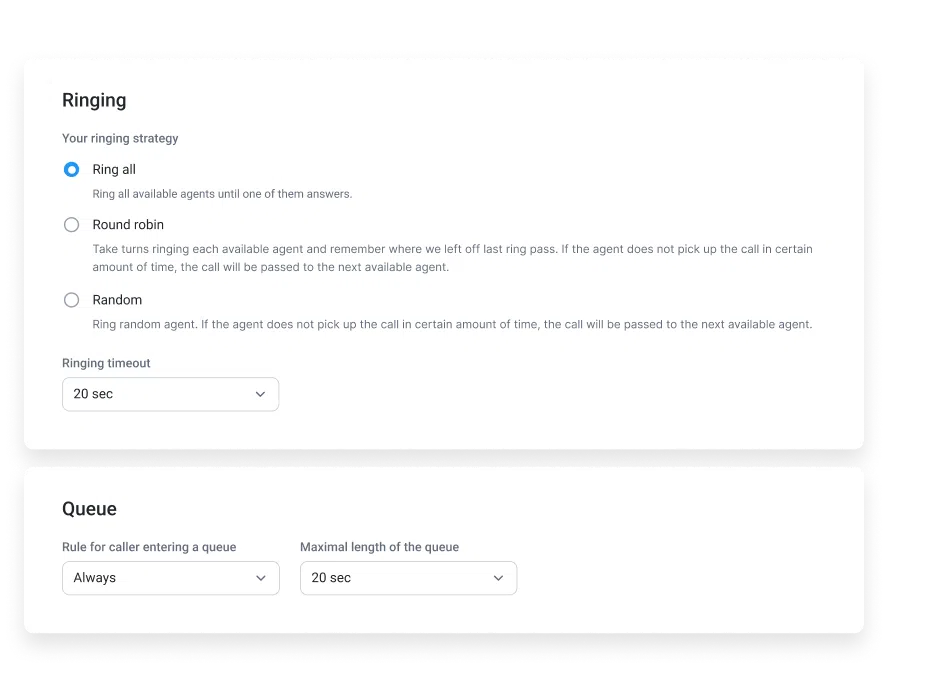
#6 Call Abandonment Rate
Your call abandonment rate represents the percentage of customers who hang up or disconnect before speaking with a representative. This gives you insights into your typical wait times.
If you have a high abandonment rate, that could mean your customers are having a hard time accessing the service they need. And if that’s the case, it might be time to look at your staffing levels. Maybe they’re overwhelmed during peak hours when there’s a high call volume.
Or, maybe you have some reps who aren’t efficient in resolving customer issues, so it leads to them not being available to answer new calls.
CloudTalk helps lower call abandonment rates with smart call routing. By quickly connecting customers to the right agent or department, it reduces wait times and frustration—making callers less likely to hang up.
When you use CloudTalk’s features, you’ll also benefit from a decentralized network that helps ensure your call center remains operational even during traffic spikes or system outages. By distributing call traffic across multiple servers, CloudTalk ensures customers are less likely to experience dropped calls or long delays in getting connected.
#7 Customer Effort Score (CES)
How much effort does it take for a customer to resolve an issue or get a service request fulfilled?
That’s your customer effort score (CES). It asks customers to rate their experience on a scale like, “How easy was it to resolve your issue?”
The higher the score, the more friction customers run into when trying to get help. A lower score, on the other hand, means your customers find it easy to get the information and help they need.
You can reduce customer effort with AI tools and self-service options.
CloudTalk’s automated call routing uses AI to analyze calls and quickly directs callers through a set of predefined options. That way, they can reach the right professionals in less time.
To improve self-service options, CloudTalk’s Interactive Voice Response (IVR) system allows customers to resolve simple queries on their own without waiting for an agent.
By providing an automated menu to guide customers to the right department or allow them to check on the status of their inquiries, IVR reduces the effort needed to get answers and speeds up the resolution process.
Practical Tips to Improve Customer Service Efficiency
So, you’ve leveraged call tracking metrics to measure customer service efficiency. Here are some practical tips:
- Use AI-Powered Tools for Smarter Call Management: CloudTalk’s AI features, like automatic call tagging and sentiment analysis, automatically analyze call content and customer sentiment.
- Provide Regular Training Based on Metric Insights: Training your agents using data from KPIs like FCR and CSAT ensures they’re always improving their skills. CloudTalk’s analytics tools make it easy to track these metrics and use them to identify areas where additional training or support is necessary.
- Leverage Real-Time Reporting and Dashboards: CloudTalk’s real-time reporting and dashboards give you the ability to monitor call activity and performance metrics instantly.
- Create content that addresses customer questions and concerns. For example, Alan’s Factory Outlet’s blog post on shed costs covers various factors that influence pricing. This type of content answers customers’ questions about costs, reducing the likelihood that they will contact customer service. This frees up customer service reps to focus on more complex issues, and in turn, contributes to improved key metrics.

Take Control of Your Customer Service
Tracking customer service efficiency is key to keeping things running smoothly. It helps you understand how well you’re serving your customers and where there’s room to improve.
Metrics like first call resolution (FCR), customer satisfaction (CSAT), and average handle time (AHT) give you the full picture of your team’s performance.
With the right tools, like CloudTalk, you can leverage AI-powered analytics, real-time reporting, and small call routing to make it easier to boost efficiency and keep your valued customers satisfied.
CTA Ready to optimize your call metrics and improve first-call resolution?

Hi, I’m Britney Steele, freelance writer with 5+ years of experience.
I have written for a variety of industries, including marketing, technology, business, finance, healthcare, wellness, and fitness. If I’m not spending my time chasing after three little humans and two four-legged friends, you can almost always find me glued to a book or awesome TV series.
FAQs
What is the most important metric for measuring customer service efficiency?
Look at first call resolution (FCR). It measures how effectively your team resolves customer issues on the first interaction.
What is customer service efficiency?
Customer service efficiency refers to how effectively and quickly a customer service team resolves customer inquiries or issues while using minimal resources. It’s about delivering high-quality support with speed, accuracy, and minimal effort from both the customer and the service agent.
Efficient customer service means shorter wait times, faster resolutions, fewer repeat contacts, and higher customer satisfaction—all while keeping operational costs low.
How can AI tools improve customer service metrics?
Sentiment analysis analyzes customer emotions so agents adjust their responses. Automatic call tagging help you sor issues right away.
What should I do if my call abandonment rate is too high?
This usually means customers are frustrated with wait times. Use smarter routing or automation to connect customers with the right person faster.
